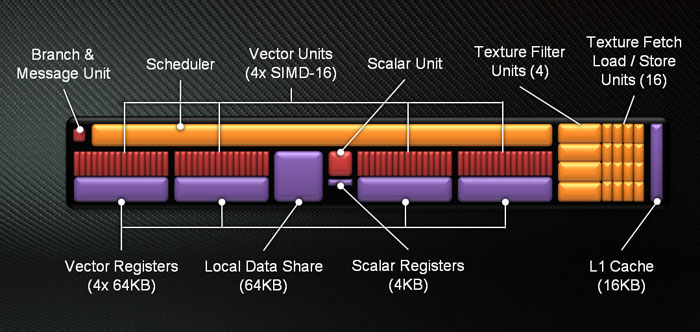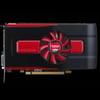The graphics engine architecture
The Graphics Engine Architecture
With the initial release of the 7000 series AMD moved away from the VLIW5 and VLIW4 architecture we have seen in the last generation of products. If anything, VLIW4 has shown certain inefficiencies in the Radeon HD 6900 series and while VLIW designs are fine for graphics, they are not so grand for computing. GCN is short for Graphics Core Next architecture and the architecture building block has changed significantly to remove certain inefficiencies seen in the VLIW architecture. A GCN in essence is the basis of a GPU that performs well at both graphical and computing tasks. For the compute side of things the new GCN Compute unit model has been introduced, it is designed for better utilization, high throughput and multi tasking, e.g. performance, performance, performance.

So your basic cluster of shader processors is one (GCN) Compute Unit:
- Non-VLIW Design
- 16 wide SIMD units
- 64 KB registers / SIMD unit
Now if we take 4 of these SIMD units that will be the basis of one Compute Unit (CU), each SIMD unit is 16 wide, times four per compute unit means that each CU has 64 shader processors.
Some examples:
- A Verde XT GPU has 10 Compute Units meaning 64SIMDs x 10 CUs = 640 Shader Processors (R7770)
- A Bonaire GPU thus has 12 Compute Units meaning 64SIMDs x 14 CUs = 896 Shader Processors (R7790)
- A Pitcairn PRO GPU has 16 Compute Units meaning 64SIMDs x 16 CUs = 1024 Shader Processors (R7850)
- A Pitcairn XT GPU has 20 Compute Units meaning 64SIMDs x 20 CUs = 1280 Shader Processors (R7870)
The Graphics Core Next Compute Unit (CU) has about the same floating point power per clock as the previous one (i.e. Cayman). It also has the same amount of register space (for the vector units). Each CU also has its own registers and local data share.
GCN is more efficient since it does not require instruction level parallelism (we assume it costs some more area/transistors as well). The outcome - compiling also becomes much more simplified and that means more efficiency and thus there it is again, better performance. GCN is all about creating a GPU good for both graphics and computing purposes.
AMD PowerTune with Boost
In December 2010, with the introduction of the AMD Radeon HD 6900 Series, GPUs included dynamic power management with AMD PowerTune technology. June 2012 saw an update to this technology with AMD PowerTune technology with Boost. With the AMD Radeon HD 7970 GHz Edition, through the use of digital temperature estimation (DTE) applications where thermal and power budgets allowed, a Boost state with a higher engine clock and the required set voltage for that state would be enabled, further pushing the performance from an already extremely high performance GPU.
2013 is marking the next update in AMD PowerTune technology with the announcement of the AMD Radeon HD 7790 graphics card. The second generation implementation of AMD PowerTune technology is designed to further provide higher sustained engine clocks, increased performance and improved power efficiency for the GPU on which this is applied.
By utilizing 8 distinct clock & voltage DPM states, and increase from 4 clock/voltage states, AMD PowerTune technology can ensure the GPU is running the optimal voltage for each clock speed being requested. Leveraging advancements on the microcontroller side based on the groundwork established by AMD APUs, the GPU will dither between DPM states as fast as every 10ms to ensure power and performance is maximized for the given design.
This now interlinks DPM and AMD PowerTune technology where the DPM state is determined based on GPU activity, current (TDC) limits, and thermal management (TDP). Additionally, by dithering between DPM states as fast as every 10ms based on the aforementioned parameters, an effective clock frequency between the two adjacent states is calculated based on the percentage of time spent in each state and visible to end users.
PCIe Gen 3
In Q3 and Q4 of 2011 we saw a lot of PCIe gen 3 motherboard announcements. What's that all about you ask? In a nutshell, PCI Express Gen 3 provides a 2x faster transfer rate than the previous generation, this delivers capabilities for next generation extreme gaming solutions. So opposed to the current PCI Express slots which are Gen 2, the PCI Express Gen 3 will have twice the available bandwidth at 32GB/s, improved efficiency and compatibility and as such it will offer better performance for current and next gen PCI Express cards. To make it even more understandable, going from PCIe Gen 2 to Gen 3 doubles the bandwidth available to the add-on cards installed, from 500MB/s per lane to 1GB/s per lane. So a Gen 3 PCI Express x16 slot is capable of offering 16GB/s (or 128Gbit/s) of bandwidth in each direction. That results in 32GB/sec bi-directional bandwidth. The big problem is that you need a symbiosis of proper compatible hardware, like a Gen 3 supporting motherboard, Gen 3 capable processor and thus a graphics card supporting the new standard. A lot of Z68 and all Z77 and X79 are PCIe Gen 3 certified. However, processor wise the Ivy Bridge CPUs from Intel support Gen 3.
DirectX 11.1
AMD's Radeon 7000 series cards support DirectX 11.1 as the hardware is compatible.
New primary features in this update are:
- Target independent rasterization
- Flexible interoperability between graphics compute and video
- Native Stereo 3D support
Eyefinity 2.0
One of the biggest success stories of the Radeon series was the introduction of Eyefinity. Eyefinity allows you to use multiple monitors in desktop and gaming mode. Typically you needed the very same monitors and resolutions, Eyefinity 2.0 changes that. You are now actually able to create a custom resolution. So if you have three differently sized monitors, you can actually get that working (not that I'd recommend it). More monitor signal bandwidth is created with the 7000 series cards as well, you may now create resolutions of 16k x 16k. This for a fact allows you to set up say five screens in 5x1 landscape mode in 1920x1200 and even 2560x1600 monitors.
Ralatively new is taskbar Positioning. Say you set up 3 or even 5 screens in landscape mode, it's always a total bitch that the start menu and icons are located all the way to the far left screen. The new feature will allow you to configure the position of the taskbar, so if you want it positioned on the middle monitor, that will become an option.




